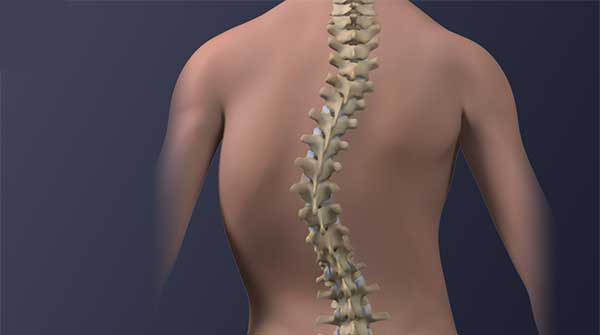Early diagnosis can lead to better treatment
A University of Alberta engineering professor has designed a portable ultrasound system that can detect scoliosis in adolescents without the risks associated with frequent X-rays.

Edmond Lou
Adolescent idiopathic scoliosis is a deformity of the spine that occurs in two to four per cent of those between the ages of 10 and 18. A lifelong and potentially progressive condition, it can cause deformity and pain later in life if untreated, says Edmond Lou of the Department of Electrical and Computer Engineering.
Lou has adapted a portable ultrasound device already available on the market by adding electronics and AI software to reconstruct a series of single images into a three-dimensional scan of the spine.
 |
| Related Stories |
| Seniors prefer home care over institutionalization
|
| Study shows promise for treating rare genetic liver disorder
|
| Research may lead to treatment of mood disorders, asthma |
“We can display the entire spine on the monitor and measure its curvature, with no X-ray involved,” says Lou, adding there is a higher presence of cancer in adolescents who need a radiograph as often as every four to six months during treatment.
Two-dimensional X-rays can also underestimate the severity of spinal deformity, he says.
He points out that a traditional ultrasound system with a 3D position sensor can cost up to US$45,000, making it too expensive for many clinics. His portable unit is estimated to cost about US$11,000.
About 30 per cent of patients with adolescent idiopathic scoliosis need active treatment, says Lou, which includes bracing and surgery.
“If we can diagnose scoliosis earlier, there will be better treatment and we can prevent people from having to do surgery,” he says.
A member of the Women and Children’s Health Research Institute, Lou says his team is one of two pioneer teams in the world using ultrasound to detect scoliosis, a project he started about 12 years ago. The other is in Hong Kong.
Similar technology can be used to monitor hip dislocation in children with cerebral palsy, he says. He has launched a spinoff company called DenSonics Imaging with Paul Major of the School of Dentistry, using portable ultrasound to assess bone strength in children’s teeth before braces are applied.
Lou plans to launch another company for the scoliosis technology once he has secured funding and a U.S. patent.
“Right now, the scanning still needs to be done in a medical clinic, but I have a new idea for the next generation so anyone can do it at home – anywhere, anytime. Everything will be automatic, and you will be able to see the scan on your phone.”
| By Geoff McMaster
Geoff McMaster is a reporter with the University of Alberta’s Folio online magazine. The University of Alberta is a Troy Media Editorial Content Provider Partner.
The opinions expressed by our columnists and contributors are theirs alone and do not inherently or expressly reflect the views of our publication.
© Troy Media
Troy Media is an editorial content provider to media outlets and its own hosted community news outlets across Canada.



Many people suffer from too much sitting as a result of technology and workplace exposure, and this activity can even damage their spines. It’s good to know that a portable ultrasound can help reach out to many other possible patients because of scoliosis. It is a big step forward in medicine and helps keep patients from getting other health problems if the problem is detected early.
Many people suffer from too much sitting as a result of technology and workplace exposure, and this activity can even damage their spines. It’s good to know that a portable ultrasound can help reach out to many other possible patients because of scoliosis. It is a big step forward in medicine and helps keep patients from getting other health problems if the problem is detected early.